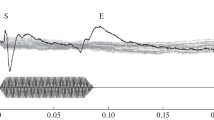Summary
During open brain surgery under local anesthesia for the treatment of medically intractable temporal lobe epilepsy we have recorded neuronal activity from the lateral temporal lobe with microelectrodes while the patients listened to short pieces of music. Three groups of music were tested: A) Simple familiar or unknown classical tunes at a simple rhythm and harmony, played on piano; B) Orchestrated folk music; C) Drumming without a tune. All types of music lead to changes of neuronal discharge rate. Musical pieces of type A produced a decrease in 48% of the recordings, an increase in about 17% and had no effect in 30%. A similar distribution of effects was found during type B-music (48%, 22%, 30%, respectively). During type C, only 26% showed a decrease and 74% an increase. When music was turned off, usually the reverse change from that caused by music was seen. In addition to changes of discharge rate, a slight entrainment of activity by single, regularly appearing notes (rhythm) was seen in some neurons. A few neurons showed a change of activity related to musical phrases (activation towards the end of a 4-bar 4/4 phrase). In contrast to the effects of verbal stimuli and overt speech, the effects of music on discharge rates did not show obvious topographical differences between superior, middle and inferior temporal gyrus. They also were bilateral with no significant right-left differences.
Similar content being viewed by others
References
Berthold H (1983) Musik und Hemisphärendominanz: Untersuchung der Ausfälle von musikalischen Hirnfunktionen anhand standartisierter Musiktests. Thesis. Universität Freiburg/Br
Bever TG, Ghiarello RJ (1974) Cerebral dominance in musicians and nonmusicians. Science 185:537–539
Clynes M (ed) (1982) Music, mind and brain. Plenum Press, New York
Creutzfeldt O, Ojemann G, Lettich E (1989a) Neuronal activity in the human lateral temporal lobe. I. Responses to speech. Exp Brain Res 77:451–475
Creutzfeldt O, Ojemann G, Lettich E (1989b) Neuronal activity in the human lateral temporal lobe. II. Responses to the subjects own voice. Exp Brain Res 77:476–489
Critchley M (1937) Musicogenic epilepsy. Brain 60:13–27
Critchley M, Henson RA (eds) (1977) Music, mind and brain. Heinemann, London
Gordon HW, Bogen JE (1974) Hemispheric lateralization of singing after intracarotid amylobarbitone. J Neurol Neurosurg Psychiat 37:727–738
Jung R (1939) Über vegetative Reaktionen und Hemmungswirkung von Sinnesreizen im kleinen epileptischen Anfall. Nervenarzt 12:169–185
Jung R (1954) Correlation of bioelectrical and autonomic phenomena with alterations of consciousness and arousal in man. In: Delafresnaye A, Bremer F, Jasper HH (eds): Brain mechanisms and consciousness. Symposion. Blackwell, Oxford, pp 310–344
Kleist K (1934) Gehirnpathologie. Johann Ambrosius Barth, Leipzig
Luria AR (1966) Higher cortical functions in man, English edition. Basic Books Inc, New York
McKee G, Humphrey B, McAdam DH (1973) Scaled lateralization of alpha activity during linguistic and musical tasks. Psychophysiology 10:441–443
Mazziotta IL, Phelps ME, Carson RE et al. (1982) Tomographic mapping of human cerebral metabolism: auditory stimulation. Neurology 32:921–937
Mazzola G, Wieser HG, Brunner V, Muzzulini D (1989) A symmetry-oriented mathematical model of classical counterpoint and related neural investigations by depth EEG. Computers Math Applic 17:539–594
Merlis JK (1974) Reflex epilepsy. In: Magnus O, Lorentz de Haas AM (eds) The epilepsies. Handbook of neurology, Vol 15. North-Holland Publ Comp, Amsterdam, pp 440–456
Milner B (1966) In: Mountcastle VB (ed) Interhemispheric relations and cerebral dominance. Johns Hopkins Press, Baltimore, pp 177–198
Petsche H, Pockberger H, Rappelsberger P (1986) EEG-topography and mental performance. In: Duffy FM (ed): Topographic mapping of the EEG. Butterworth, Boston, pp 63–98
Petsche H, Lindner K, Rappelsberger P, Gruber G (1988) The EEG — an adequate method to concretize brain processes elicited by music. Music Perception 6:133–159
Walker JL (1980) α-EEG correlates of performance on a musical recognition task. Physiol Psychol 8:417–420
Wieser HG, Mazzola G (1986) Musical consonances and dissonances: are they distinguished independently by the right and left hippocampi? Neuropsychologia 24:805–812
Author information
Authors and Affiliations
Rights and permissions
About this article
Cite this article
Creutzfeldt, O., Ojemann, G. Neuronal activity in the human lateral temporal lobe. Exp Brain Res 77, 490–498 (1989). https://doi.org/10.1007/BF00249602
Received:
Accepted:
Issue Date:
DOI: https://doi.org/10.1007/BF00249602




